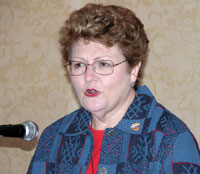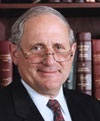 Archer Daniels Midland CEO Patricia Woertz is expecting big profits from biofuels for her company in the next few years. According to an AP article, Woertz said profits from the renewable fuel plants “will be quite robust at something less than that.” Speaking by webcast from a conference in Paris Tuesday, Woertz also said that while there are a number of new competitors in the business, ADM’s advantage is “around experience, network capabilities and cost advantages.” ADM is the largest producer of ethanol, with a 25 percent market share.
Archer Daniels Midland CEO Patricia Woertz is expecting big profits from biofuels for her company in the next few years. According to an AP article, Woertz said profits from the renewable fuel plants “will be quite robust at something less than that.” Speaking by webcast from a conference in Paris Tuesday, Woertz also said that while there are a number of new competitors in the business, ADM’s advantage is “around experience, network capabilities and cost advantages.” ADM is the largest producer of ethanol, with a 25 percent market share.
Incidentally, there was a little piece of financial advice in USA Today this week about whether now would be a good time to invest in ADM to take part in the growth of alternative fuels. Financial writer Matt Krantz says, “It sounds corny, but you are late to this party.”
Meanwhile, VeraSun’s party is just getting started.


 Financial services are buzzing this morning with the red-hot debut of VeraSun’s IPO. In the most recent
Financial services are buzzing this morning with the red-hot debut of VeraSun’s IPO. In the most recent  Hello from San Francisco. I know I said I’d start blogging the AASHTO 50th Anniversary of the Interstate event tomorrow but things got kicked off today. Right now those of us participating in the convoy that will take off Friday are getting prepped by Sunny Schust, director of communications for the
Hello from San Francisco. I know I said I’d start blogging the AASHTO 50th Anniversary of the Interstate event tomorrow but things got kicked off today. Right now those of us participating in the convoy that will take off Friday are getting prepped by Sunny Schust, director of communications for the 

 America is not the only country addicted to oil. China is now considering a change in energy policy to encourage the wider use of ethanol in order to improve air quality. According to
America is not the only country addicted to oil. China is now considering a change in energy policy to encourage the wider use of ethanol in order to improve air quality. According to  Louisiana Governor Kathleen Blanco has signed into law a bill requiring refineries to mix ethanol with some of the gasoline they produce.
Louisiana Governor Kathleen Blanco has signed into law a bill requiring refineries to mix ethanol with some of the gasoline they produce. 

 Sixteen members of Michigan’s congressional delegation, including Senators Carl Levin and Debbie Stabenow, are calling on President Bush to pressure oil companies into setting a target for installing more ethanol filling stations by 2010. According to the
Sixteen members of Michigan’s congressional delegation, including Senators Carl Levin and Debbie Stabenow, are calling on President Bush to pressure oil companies into setting a target for installing more ethanol filling stations by 2010. According to the  Engineering students from Virginia Tech University, utilizing E85/hybrid technology, beat out teams from 16 other universities in the U.S. and Canada to win the second annual
Engineering students from Virginia Tech University, utilizing E85/hybrid technology, beat out teams from 16 other universities in the U.S. and Canada to win the second annual  Texas-based
Texas-based